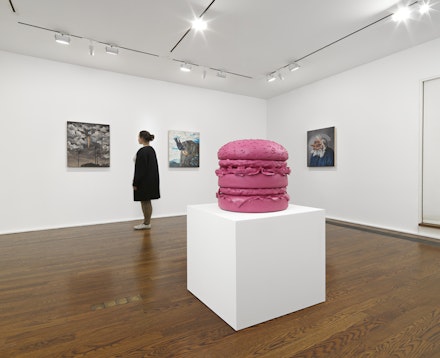ArtSeen
Djordje Ozbolt More paintings about poets and food
On View
Hauser & WirthJanuary 14 – February 21, 2015
New York
The title of Djordje Ozbolt’s recent show More paintings about poets and food is a clever riff on the 1978 Talking Heads album More Songs About Buildings and Food. The cover art for the album, created by the late Downtown scene icon Jimmy DeSana, is a collage that distorts the appearance of the band members like a Hannah Höch collage. Similarly, in Ozbolt’s new exhibition at Hauser & Wirth, Ozbolt manipulates art-historical categories and source materials that rework traditional expectations about painting. He alludes to the punk aesthetic that I consider understated subversion—irreverence combined with a sophisticated and technically proficient practice. As a result, the show, filled to the brim with stand-alone works and a massive 50-part painting installation called “50 ways to leave your lover” (2014), is a welcome critique of painting that spans multiple media, histories, and styles.
At the outset, Ozbolt willingly calls himself out as a fraud of sorts in works such as “The Intruder”(2014), a traditional still life that has been invaded by a lobster, a Big Mac, and the corpse of a dead bird, and thus, in a sense, by the artist himself. “The Intruder” combines the tactile, fleshy quality of an 18th century painting, Chardin’s famous “The Ray” (1728), with an emphasis on surface, a surreal artifice that causes the viewer to wonder if the lobster will come to life. It is as if Ozbolt has combined “The Ray” with a work by de Chirico, creating a strange otherworld where the spilling guts of the marine creature meet the vast and dark landscapes of Surrealist painting. “The Intruder” is therefore more than a facile comment on consumer culture simply by including a Big Mac in a still life; it also combines methods of representation that allow for a fresh consideration of both still life and Surrealism.
When discussing Surrealism, it is impossible to escape the embedded aspect of primitivism, a lineage that Ozbolt turns on its head with his Rousseau-like landscapes. Although much of the Surrealist project was based on appropriating from other cultures and attempting to approximate a pre-industrial state of consciousness, Ozbolt utilizes the tradition of exoticism as an opportunity to think more critically about this art-historical problematic. “Me and My Pets” (2014), a piece reminiscent of Georgia O’Keeffe’s glamorized landscapes of the American West populated by skulls, projects a critical view of primitivism. Ozbolt’s painting shows a decorative vase with skulls and an unidentifiable tome, all in front of a cave-like background. The vase, beautifully decorated, stands in contrast to its macabre counterparts in the composition, the skulls—one human, one mammal, and one bird. The skull has long been a tool of scientific racism, and Ozbolt’s title engages the absurdity of this history. Who is “Me?” We are forced to ask ourselves, and of course, none of these objects are pets; they belong to no one—not to science, not to the artist. The skulls are so perfectly, impossibly balanced, adding to the disorientation of a racist tradition. This is hardly the combination of Western and “exotic” modes by an all-knowing male artist; it is a sophisticated critique that transcends co-opting culture in favor of pointing out the flaws therein.
Finally, “50 ways to leave your lover”—which includes the crate that the series was shipped in—seems to preside over the exhibition, coalescing all of these themes by exposing the contracted nature of painting and the art world. These paintings in a plethora of styles point not only to Ozbolt’s skill as a portraitist and an abstract artist, but also the beautiful variety of life. The crate, central to the presentation of the paintings, is both a storage object and an interior space to which we are not given access. Itself a readymade, it is a threshold into countless worlds—commerce, the mind of the artist, the ephemeral nature of the art object. Ozbolt has given us access to a basic element of his process—shipping the works—in order to exemplify the humor inherent in his practice. His sharp wit comes to the fore; his paintings are packaged and shipped constructions that, as a result, call into question art-historical truisms.



